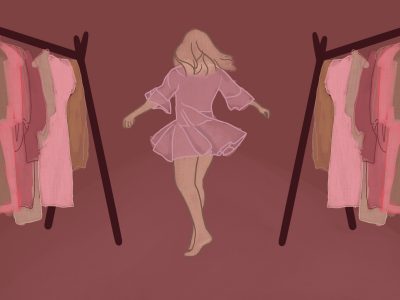Thrifting has always been the sustainable, affordable alternative to fast fashion. Although buying second-hand has most popularly been used by lower- and middle-income families, it has slowly journeyed from stigmatized to mainstream.
As more people opt for the thrifting experience, it’s likely there will be an increasing number of upper-class shoppers. That would mean more people who could afford the same styles at retail price choosing instead to recycle gently used clothing.
I’m no exception when it comes to falling for the unbeatable thrift-store find. There is a charm to making a day out of shuffling through racks in a locally owned thrift shop in the East Village. Each piece feels unique, and after hours of searching, you find the slightly worn, oversized band T-shirt you didn’t even realize you wanted.

Watching popular fashion YouTuber bestdressed’s thrift haul in New York City was the first time I truly confronted these changing attitudes about used clothing. She walked her viewers through her experience as a shopper, her favorite stores and NYC’s expensive prices.
It was difficult for me to avoid the uncomfortable feeling of familiarity in her video. Impulsively, I became possessive over the stores she frequented the most. It was because I could recognize the store layouts and linoleum floors.
They were the same locally owned thrift shops in the East Village I spent entire days at with my friends.
Considering she is a popular influencer who can comfortably live by herself in Manhattan, bestdressed sharing this information about local thrift shops to 1.7 million viewers felt like a betrayal. It was as though she had revealed a well-kept secret meant only for my neighborhood.
Now, people who didn’t even need to thrift had their very own navigation guide for New York’s hottest deals. It was absolutely unfair.
But was it? After all, who was I to gatekeep thrift shopping? By my own standards, didn’t I match the description of the well-off New Yorker using second-hand clothing as a stylish hobby?

I didn’t really need anything I was buying, and maybe there was someone who did need that blazer I bought for a job interview, or could only afford that slightly worn, oversized band T-shirt at a second-hand price.
Part of this gentrification of thrift stores is the result of buying used clothing as a hobby. And although it’s important to acknowledge that thrift shopping is a more sustainable alternative to an industry responsible for producing 706 million tons of greenhouse gases annually, to lower- and middle-class shoppers it can sometimes be one of the few, limited options.
Which is to say, if the market is saturated with upper-middle-class adults who can afford other options, those in lower income brackets will sometimes be forced to shop at fast-fashion chain stores to purchase clothing at low prices.
For those who can afford it, purchasing high-quality, sustainable clothing from an ethical brand at retail price is a way to minimize our ecological footprint and keep second-hand clothing for those who need it.
That being said, there’s also nothing wrong with enjoying thrift shopping and going out with your friends to find unique pieces. We just need to be mindful about what our clothing could mean to someone else.




